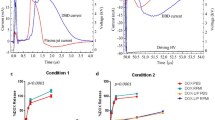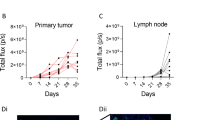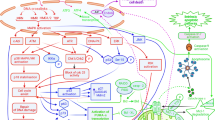Abstract
A B16 mouse melanoma cell line resistant to doxorubicin was obtained by continuous in vitro exposure to the drug. The ID50 for this line was 200 times higher than that for the parental cell line. The resistant cell line had some biological characteristics similar to those of the sensitive parental cell line, like saturation density and protein content. Differences were found in doubling time which was longer, cloning efficiency which was lower and DNA content which was higher in the resistant as compared to the parental line. Intracellular distribution of doxorubicin was also different having a nuclear-cytoplasmic ratio higher in sensitive than in resistant cells. Melanin content was an unstable feature in the sensitive cell line, whereas melanin was always present in resistant cells. Resistance to doxorubicin was maintained during 50 in vitro passages in the absence of the drug. Cross-resistance was found with vincristine and other anthracyclines, like daunorubicin and 4'-epi-doxorubicin but not with cis-platinum, and a new doxorubicin derivative, 4'-deoxy-4'-iodio-doxorubicin. The B16 line showed a lower resistance index to 4'-deoxy-doxorubicin and 4-demethoxy-daunorubicin (30 and 3 respectively), as compared to doxorubicin. Doxorubicin-resistance was partially circumvented by pretreatment of resistant cells with verapamil, a calcium chelating agent, and by trifluoperazine, a calmodulin-antagonist.
This is a preview of subscription content, access via your institution
Access options
Subscribe to this journal
Receive 24 print issues and online access
$259.00 per year
only $10.79 per issue
Buy this article
- Purchase on Springer Link
- Instant access to full article PDF
Prices may be subject to local taxes which are calculated during checkout
Similar content being viewed by others
Rights and permissions
About this article
Cite this article
Supino, R., Prosperi, E., Formelli, F. et al. Characterization of a doxorubicin-resistant murine melanoma line: Studies on cross-resistance and its circumvention. Br J Cancer 54, 33–42 (1986). https://doi.org/10.1038/bjc.1986.149
Issue Date:
DOI: https://doi.org/10.1038/bjc.1986.149
This article is cited by
-
The glycocalyx maintains a cell surface pH nanoenvironment crucial for integrin-mediated migration of human melanoma cells
Pflügers Archiv - European Journal of Physiology (2009)
-
Characterization of an established human, malignant, glioblastoma cell line (GBM) and its response to conventional drugs
Journal of Cancer Research and Clinical Oncology (1994)
-
Evaluation of a platinum-doxorubicin complex in experimental tumor systems
Investigational New Drugs (1990)
-
Susceptibility of human and murine drug-resistant tumor cells to the lytic activity of rIL2 - activated lymphocytes (LAK)
Cancer and Metastasis Review (1988)
-
Limitations of the quantitative cytochemical assay of catechol oxidase in melanoma cells
The Histochemical Journal (1988)



